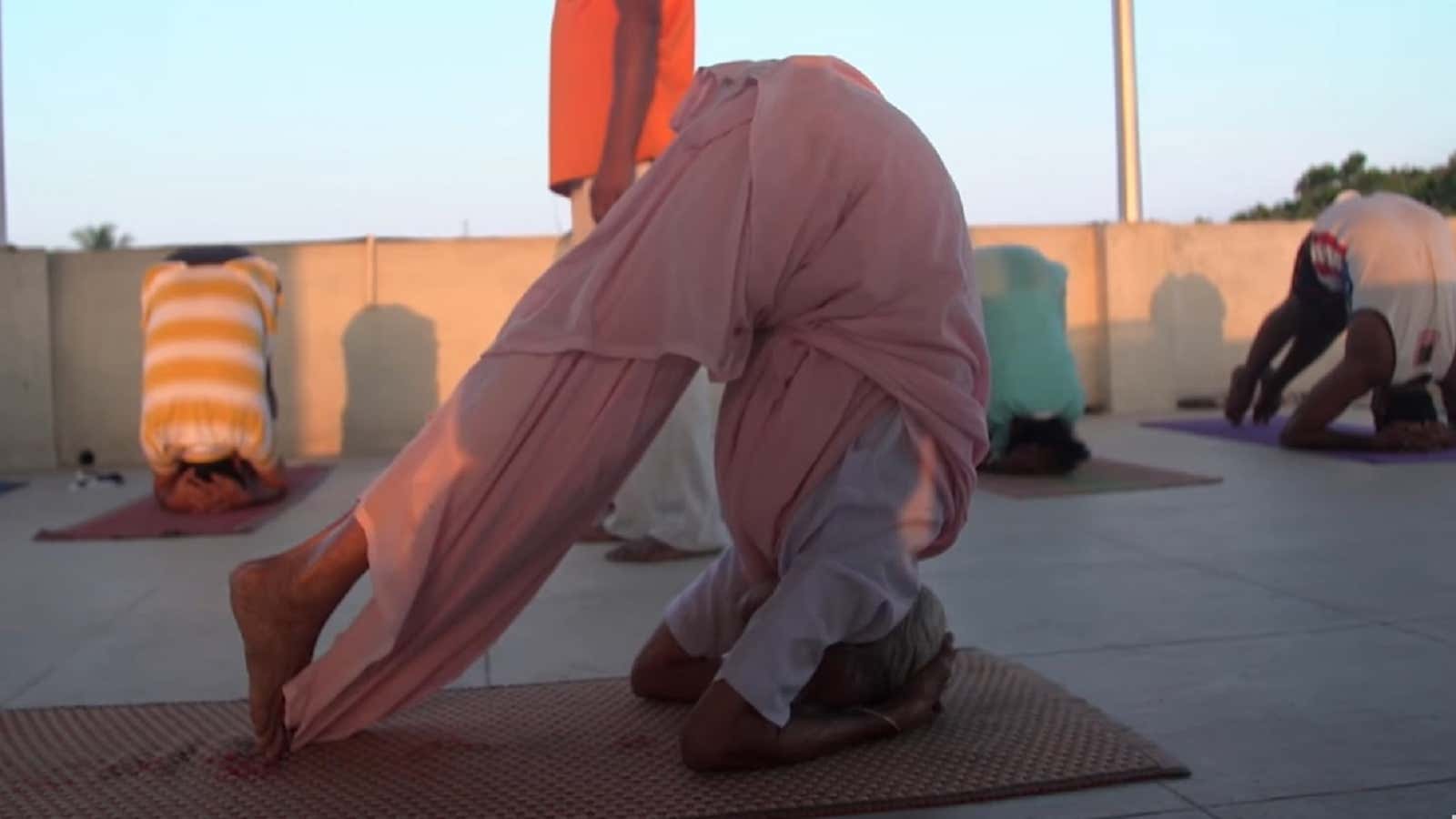Update: V Nanammal died on Oct. 29, 2019 at her home near Coimbatore, Tamil Nadu. She was 99.
If you’re a power yoga enthusiast or a hot yoga buff with the ability to pull off 100 surya namaskaras (sun salutations) in one go, India’s oldest yoga teacher wants you to know you’re doing it all wrong.
V Nanammal, the 98-year-old yoga expert from the southern state of Tamil Nadu, believes that, in its true form, yoga isn’t about rigorous activity or getting all sweaty and breathless; it’s about peace and relaxation, and this is what she’s been practicing every day for nearly a century.
Despite her age, Nanammal can effortlessly curl into any yoga asana you name, an ability that’s earned her accolades and awards. To this day, she’s never stepped into a hospital and seems healthier than most millennials, for all their dieting and exercise. She’s now become a celebrity in the yoga, and wellness world and videos of her performing complicated aasanas have gone viral, attracting millions of views.
When it comes to yoga, Nanammal and her family, which includes her children, grandchildren, and even great-grand children, follow the traditions passed on from generation to generation. At the Ozone Yoga centre in Coimbatore, which they established in 1972, they teach their traditional style of yoga, which focuses on pranayama (breath control).
But you won’t find any Lululemon yoga pants or specialised yoga mats here. Nanammal only wears traditional clothing and practices on a simple carpet. Her lifestlye is similarly minimalist: simple meals of porridge made with millets for breakfast, greens and rice for lunch, and milk and fruits for dinner. She also asks her students to avoid meat, cigarettes, and alcohol.
All this sets her apart from the billion-dollar yoga industry as it exists in urban India and around the world. The craze for power yoga, with its intense, brisk movements, and even hot yoga, performed in humid conditions, has fueled a boom in classes, clothing, and accessories, particularly in the US. But to traditionalists like Nanammal and her family, these practices are just exercise, and have very little to do with the true form of yoga. For instance, Nanammal maintains that the asanas of the surya namaskar routine shouldn’t be performed more than the traditional 12 times. And yet, yoga enthusiasts sometimes do it as an exercise, repeating the asanas as much as they can.
The unlikely celebrity
For Nanammal, becoming a worldwide yoga sensation was hardly a conscious choice. Long before she and her children made yoga their “full-time profession,” the practice was simply a family affair, something that everyone performed at home, including her mother Ponammal, who lived to be 107.
“My father and grandfather were both RIMPs (Registered Indian Medicine Practitioners) and weren’t teaching yoga to anyone outside the family,” V Balakrishnan, Nanammal’s son, who is also a yoga teacher, told Quartz. “It was a family tradition and stayed within the group.” At the time, the primary business was agriculture in Kerala, where the family owned cashew and coconut farms, as well as traditional Siddha medicine.
It was an incident involving her mother-in-law that made Nanammal realise that yoga could potentially help other people, too.
“My mother-in-law was out in the farm and had sprained her leg,” Nanammal explained in Tamil. “Instead of getting her to see a doctor, I offered to teach her some yoga poses and she got better.”
After that, her mother-in-law became her very first student. Over the years, Nanammal began teaching her neighbours and other children, and by the 1970s, she had decided she wanted to teach yoga to even more people. So, the Ozone Yoga school was established, and since then, Nanammal and her family have taught over 100,000 people. But the rules here are strict—students can’t wear shoes while doing yoga, for instance—and Nanammal doesn’t hesitate to ask students to leave if they don’t follow them.
About 20 years ago, the family decided to also start training other people to teach yoga. To offer certificate courses, they partnered with the Bharat Sevak Samaj, an Indian government initiative to involve citizens in development programmes. Over 1,000 people have completed the naturopathy yogic science program that Ozone offers, and many of them are now teaching yoga across several countries, including China, Singapore, and Malaysia, Balakrishnan says.
But of course, things are slowly changing with the times, he added. Now, the institute is gradually becoming more lenient than Nanammal would like, allowing non-traditional clothing to be worn at classes and smokers to enroll in the programmes. And while Nanammal firmly believes yoga should only be practiced between 3am and 5am in the morning, the brahma muhurtam or auspicious time, classes at Ozone are now held throughout the day to accommodate working professionals and students. The institute has also opened itself up to people of all religions from all over India and abroad, and doesn’t restrict classes to Hindus the way it used to.
“We aren’t strict because we want more people to learn yoga,” Balakrishnan said.
But the one thing that hasn’t changed is their focus on the original form of yoga, a world away from fads such as beer yoga or goat yoga.
“I am just focused on teaching what I have done for years now, so the next generation can learn and hold on to our traditions,” Nanammal said.
